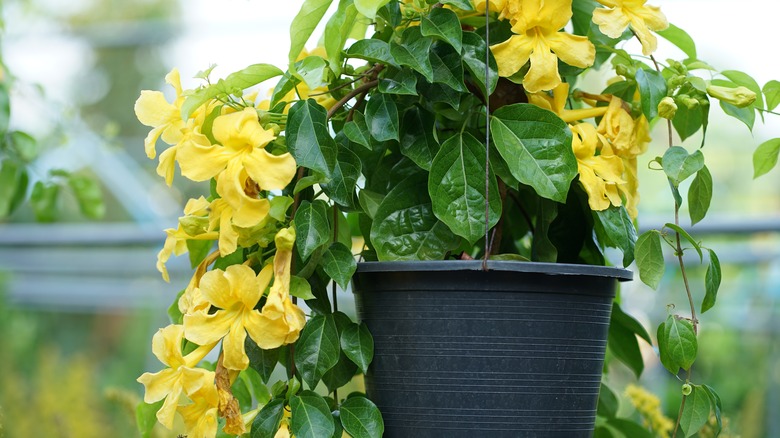Cat's Claw Vine Has A Dark Side To Know About Before Growing It In Your Garden
Developing a garden in your backyard is a wonderful way to express your green thumb skills, and familiarizing yourself with different plants and learning their unique needs is a huge part of honing this hobby. Cat's Claw is an interesting plant that's becoming popular due to its vibrant yellow flowers that speckle the dramatic limbs of this vine as it lurches over walls, gates, and trellises. Known for its medicinal properties and ornamental aesthetic, Cat's Claw vine is widely appreciated for its versatile offerings, including its ability to attract pollinators and birds with its small fruits. That being said, this plant can be quite aggressive when grown in small gardens and should be closely monitored in order to prevent it from conquering your garden.
Despite its enticing allure, Cat's Claw vine can pose some significant challenges in a small garden setting. Known for its rapid growth and vigorous climbing habits, it can quickly overtake other nearby plants and structures, unintentionally smothering them as it dominates its habitat. In order to prevent it from wiping out its close competitors, Cat's Claw requires frequent pruning and management in order to restrict its tendency to spread and overtake its neighbors. It's considered an invasive species, as many native plants struggle to compete with its aggressive nature. While it's possible to harness the beauty and benefits of Cat's Claw, it's important to acknowledge that it can also threaten other cherished plants, so there's a serious risk to adding it into your garden.
How to remove Cat's Claw vine
Should you find that a Cat's Claw vine has wreaked havoc on other plants in your yard and you wish to remove this invasive plant species, there are steps you can take to safely eliminate it from your property. To start, you should identify where this flora is prominent in your yard, including all vines and nearby underground roots. Wear protective clothing including gloves and long sleeves, as Cat's Claw vines are known to have thorns and hairs that will irritate your skin if you come in direct contact with them.
Cut back all above-ground growth using clean pruning shears or a sharp knife. Trim these vines as close to the ground as possible, disposing of all plant material to prevent re-sprouting. On that note, do not add these vines to your compost, as the seeds could survive and reestablish themselves in your garden later. Check all nearby trees, structure, and plants to be sure that any vines are completely removed from your property. After pruning its limbs, you'll need to dig up its root system using a shovel or garden fork. Loosen the base with your tool and dig deeply to unearth and discard as many roots as possible, as root fragments can generate new plants. Dispose of these in yard waste bags as well to prevent them from growing in your compost pile. Once you've removed all of the Cat's Claw, monitor the area for regrowth and promptly remove any new vines.
Cautions for containing Cat's Claw if you want to grow it
While Cat's Claw vine can be an incredibly invasive species in your yard, it does have its appeal, particularly as a potential dietary supplement that can allegedly help to stimulate your immune system. No matter your reason for growing it, there are ways you can safely do so to take advantage of its medicinal properties without putting much risk to your other garden flora. One of the best ways to safely grow this plant on your property is to cultivate it in a container or raised bed that can be easily monitored and restricted in order to prevent it from spreading too quickly or too far within your garden. In this way, you can limit its root system and more easily prune it to prevent the vines from becoming unruly or threatening other nearby plants.
Another way you can contain Cat's Claw vine is to stop it from self-seeding by removing any ripe berries. These berries will eventually fall to the ground and germinate, creating new plants by dispersing its seeds. Mulching around the plant at its base can also prevent the berries from making contact with the soil and seeding, ultimately eliminating the ability of Cat's Claw vine to create any new plants nearby. This practice is important because these vines can quickly establish themselves through its claw-like tendrils, which can rapidly adhere to and smother nearby plants like trees to overtake their resources.


